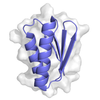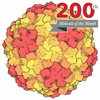+ Open data
Open data
- Basic information
Basic information
| Entry | Database: PDB / ID: 9o5w | ||||||
|---|---|---|---|---|---|---|---|
| Title | CryoEM structure of Wuhan spiny eel influenza virus (WSEIV) HA | ||||||
 Components Components |
| ||||||
 Keywords Keywords | VIRAL PROTEIN / Wuhan spiny eel influenza virus / WSEIV / Flu Hemagglutinin / HA / VIRUS | ||||||
| Function / homology |  Function and homology information Function and homology informationhost cell surface receptor binding / endocytosis involved in viral entry into host cell / fusion of virus membrane with host plasma membrane / fusion of virus membrane with host endosome membrane / viral envelope / virion attachment to host cell / host cell plasma membrane / membrane Similarity search - Function | ||||||
| Biological species |  Wuhan spiny eel influenza virus Wuhan spiny eel influenza virus | ||||||
| Method | ELECTRON MICROSCOPY / single particle reconstruction / cryo EM / Resolution: 2.67 Å | ||||||
 Authors Authors | Huang, J. / Han, J. / Ward, A.B. | ||||||
| Funding support |  United States, 1items United States, 1items
| ||||||
 Citation Citation |  Journal: bioRxiv / Year: 2025 Journal: bioRxiv / Year: 2025Title: Characterization of the glycoproteins of novel fish influenza B-like viruses. Authors: Gagandeep Singh / Jiachen Huang / Disha Bhavsar / Kirill Vasilev / James A Ferguson / Geert-Jan Boons / Viviana Simon / Robert P de Vries / Julianna Han / Andrew Ward / Florian Krammer /    Abstract: Novel influenza-like virus sequences previously identified in fish and amphibians were found to cluster as a sister clade of influenza B viruses, but have thus far remained uncharacterized. We ...Novel influenza-like virus sequences previously identified in fish and amphibians were found to cluster as a sister clade of influenza B viruses, but have thus far remained uncharacterized. We demonstrate that salamander influenza-like virus (SILV) HA is functionally divergent from influenza B virus HA and does not bind to α 2,3- and α2,6-linked sialic acids. However, the HAs of Siamese algae-eater influenza-like virus (SAEILV) and chum salmon influenza-like virus (CSILV) bind to α2,3 linked sialic acid. Furthermore, SAEILV HA binds to sialyated Lewis X, is activated by human airway enzymes and is fusogenic at a wide range of pH conditions. SAEILV NA has a highly conserved active site and a similar structure to other known NAs. We also determined the cryo-electron microscopy structure of the HA of a previously described virus from the same sister clade, the Wuhan spiny eel influenza virus (WSEIV). Importantly, no cross-reactive antibodies against these HAs or NAs were found in the human serum, suggesting that humans are immunologically naïve to these viruses. | ||||||
| History |
|
- Structure visualization
Structure visualization
| Structure viewer | Molecule:  Molmil Molmil Jmol/JSmol Jmol/JSmol |
|---|
- Downloads & links
Downloads & links
- Download
Download
| PDBx/mmCIF format |  9o5w.cif.gz 9o5w.cif.gz | 286.5 KB | Display |  PDBx/mmCIF format PDBx/mmCIF format |
|---|---|---|---|---|
| PDB format |  pdb9o5w.ent.gz pdb9o5w.ent.gz | 231.3 KB | Display |  PDB format PDB format |
| PDBx/mmJSON format |  9o5w.json.gz 9o5w.json.gz | Tree view |  PDBx/mmJSON format PDBx/mmJSON format | |
| Others |  Other downloads Other downloads |
-Validation report
| Summary document |  9o5w_validation.pdf.gz 9o5w_validation.pdf.gz | 1.7 MB | Display |  wwPDB validaton report wwPDB validaton report |
|---|---|---|---|---|
| Full document |  9o5w_full_validation.pdf.gz 9o5w_full_validation.pdf.gz | 1.7 MB | Display | |
| Data in XML |  9o5w_validation.xml.gz 9o5w_validation.xml.gz | 51.2 KB | Display | |
| Data in CIF |  9o5w_validation.cif.gz 9o5w_validation.cif.gz | 76.4 KB | Display | |
| Arichive directory |  https://data.pdbj.org/pub/pdb/validation_reports/o5/9o5w https://data.pdbj.org/pub/pdb/validation_reports/o5/9o5w ftp://data.pdbj.org/pub/pdb/validation_reports/o5/9o5w ftp://data.pdbj.org/pub/pdb/validation_reports/o5/9o5w | HTTPS FTP |
-Related structure data
| Related structure data |  70149MC  9o5uC M: map data used to model this data C: citing same article ( |
|---|---|
| Similar structure data | Similarity search - Function & homology  F&H Search F&H Search |
- Links
Links
- Assembly
Assembly
| Deposited unit | 
|
|---|---|
| 1 |
|
- Components
Components
| #1: Protein | Mass: 36282.379 Da / Num. of mol.: 3 Source method: isolated from a genetically manipulated source Source: (gene. exp.)  Wuhan spiny eel influenza virus / Production host: Wuhan spiny eel influenza virus / Production host:  #2: Protein | Mass: 19870.354 Da / Num. of mol.: 3 Source method: isolated from a genetically manipulated source Source: (gene. exp.)  Wuhan spiny eel influenza virus / Production host: Wuhan spiny eel influenza virus / Production host:  #3: Polysaccharide | 2-acetamido-2-deoxy-beta-D-glucopyranose-(1-4)-2-acetamido-2-deoxy-beta-D-glucopyranose Source method: isolated from a genetically manipulated source Has ligand of interest | N | Has protein modification | Y | |
|---|
-Experimental details
-Experiment
| Experiment | Method: ELECTRON MICROSCOPY |
|---|---|
| EM experiment | Aggregation state: PARTICLE / 3D reconstruction method: single particle reconstruction |
- Sample preparation
Sample preparation
| Component | Name: Wuhan spiny eel influenza virus (WSEIV) HA trimer / Type: COMPLEX / Entity ID: #2 / Source: RECOMBINANT | ||||||||||||||||||||
|---|---|---|---|---|---|---|---|---|---|---|---|---|---|---|---|---|---|---|---|---|---|
| Source (natural) | Organism:  Wuhan spiny eel influenza virus Wuhan spiny eel influenza virus | ||||||||||||||||||||
| Source (recombinant) | Organism:  | ||||||||||||||||||||
| Buffer solution | pH: 7.4 | ||||||||||||||||||||
| Buffer component |
| ||||||||||||||||||||
| Specimen | Conc.: 0.7 mg/ml / Embedding applied: NO / Shadowing applied: NO / Staining applied: NO / Vitrification applied: YES | ||||||||||||||||||||
| Vitrification | Instrument: FEI VITROBOT MARK IV / Cryogen name: ETHANE / Humidity: 100 % / Chamber temperature: 277.15 K |
- Electron microscopy imaging
Electron microscopy imaging
| Experimental equipment |  Model: Titan Krios / Image courtesy: FEI Company |
|---|---|
| Microscopy | Model: TFS KRIOS |
| Electron gun | Electron source:  FIELD EMISSION GUN / Accelerating voltage: 300 kV / Illumination mode: FLOOD BEAM FIELD EMISSION GUN / Accelerating voltage: 300 kV / Illumination mode: FLOOD BEAM |
| Electron lens | Mode: BRIGHT FIELD / Nominal defocus max: 1700 nm / Nominal defocus min: 700 nm |
| Image recording | Electron dose: 50 e/Å2 / Film or detector model: GATAN K3 (6k x 4k) |
- Processing
Processing
| EM software |
| ||||||||||||||||||||
|---|---|---|---|---|---|---|---|---|---|---|---|---|---|---|---|---|---|---|---|---|---|
| CTF correction | Type: PHASE FLIPPING AND AMPLITUDE CORRECTION | ||||||||||||||||||||
| Symmetry | Point symmetry: C3 (3 fold cyclic) | ||||||||||||||||||||
| 3D reconstruction | Resolution: 2.67 Å / Resolution method: FSC 0.143 CUT-OFF / Num. of particles: 198768 / Symmetry type: POINT | ||||||||||||||||||||
| Refinement | Highest resolution: 2.67 Å Stereochemistry target values: REAL-SPACE (WEIGHTED MAP SUM AT ATOM CENTERS) |
 Movie
Movie Controller
Controller






 PDBj
PDBj





